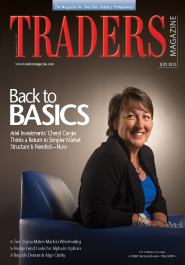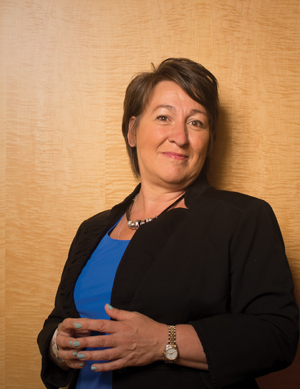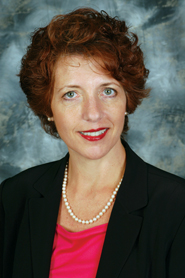Trading has gotten too complex.
Too many order types. Too many trading venues. Too many algorithms. It’s time for the equities market to get back to basics and start fresh.

That’s what trading pro Cheryl Cargie, senior vice president and head trader at Chicago-based Ariel Investments LLC, believes. And that means a return to the “good ol’ days” of trading-a simpler time, she said. Her ideal trading ecosystem wouldn’t have such things as high-frequency traders, 40-plus trading venues described as “lit” or “dark,” or prices quoted in penny or sub-penny increments.
Her ideal trading world would also prohibit exchanges from paying rebates to high-frequency traders. The public stock exchanges would go back to being nonprofit entities, she added. Lastly, there’d be markedly fewer order types.
“I’m all about old-school trading,” Cargie said. “If you can end payment for flow and take away the pressure for exchanges to turn a profit, then maybe HFT will go away and real liquidity will come back to the market.”
Tough words.
Cargie wants to find natural liquidity easily, and in today’s complex market structure, it is harder than ever to find it, she said. Cargie has been in the trading business since 1986. She remembers a simpler market structure, when the floor specialist was a friend and the New York Stock Exchange was “the biggest dark pool” of them all.
That’s when she began trading. Armed with a degree in finance, the then-23-year-old received a two-week crash course from anyone who would help.
“The hardest part of this baptism by fire was learning the trading desk language,” Cargie recalled. “And the language was spoken in short bursts followed by a hang-up.”
Despite the short calls, and after many of these staccato-burst exchanges, Cargie caught onto the language of trading-hitting bids, lifting offerings, butterfly stips and barbell trades. It was pure trading and exciting.
But it was the adrenaline rush of the trading desk-sitting amongst the shouting, the camaraderie, the raw energy of the desk-that captivated her then and now, she said. “In college they never told you what a trading desk was like, but when I got there and took it all in, I knew I wanted to stay.”
She began trading shortly after landing a job in the investments department at Combined Insurance at the age of 23. After that, Cargie moved to Fiduciary Management Associates, a small Chicago-based money manager, where she learned the fixed-income business. She learned the trading and operations side of that business, inputting her own trades into the desk’s system, and the mechanics of clearing through the Depository Trust Company.
Then, through the trading grapevine, she heard that Ariel Investments was seeking a small-cap trader. The change from fixed-income to equities peaked her interest.
“They put the word out they were looking for a trader, and I got wind of it,” Cargie said. That was 1994. She quickly accepted the position and has never looked back.
Today, Cargie trades mostly small and micro-caps for Ariel, a job that requires a high-touch approach, given the low-volumes and wide spreads in the names she wants. She prefers trading in the upstairs markets. Why? So she can quietly find and trade blocks. Her brokers offer her small-cap algorithms, but she’d rather pass on them and work the trade manually.
“I do some low-touch trading while looking for the other side of a trade, but I really rely on my high-touch traders,” Cargie said. “Unfortunately, a high percentage of algos don’t work for my names, and there’s been a big shift away from high-touch by the bulge firms. I’m scouring for names constantly.”
But that hasn’t stopped her or ended her love of trading. Nineteen years later, she still feels and lives the excitement she felt when she started.

However, she is not thrilled about some of the developments and changes she has lived through in the last 20 years. Cargie makes no bones about her concerns over the changes in the business, which she said have hurt the market: for-profit exchanges, paying rebates or the maker-taker pricing model, high-frequency trading and the rise of myriad order types.
The exchanges’ push to go public almost 10 years ago was necessary for their survival, according to remarks made by Dick Grasso, former CEO of the New York Stock Exchange, and Leo Melamed, past chairman of the Chicago Mercantile Exchange, at a recent conference hosted by Sandler O’Neill & Partners. The two both said that becoming for-profit entities and listing their own shares helped make the venues more flexible, kept ownership and trading in the U.S. and financed their electronification.
But Cargie is unmoved.
Unlike the earlier days of trading, when the exchanges were simply facilitators where buyers and sellers could meet, the focus has shifted to profit-and-loss statements and shareholder demands. Exchanges, she complained, are more concerned with the number of shares that cross rather than matching up buyers and sellers or capital formation.
“When they made the exchanges for-profit, that really hurt the market,” she said. “They’re more concerned about shareholders than stakeholders.”
This belief has led Cargie, like other buysiders, to shift more of her trades to the upstairs or private markets. Ariel can get better executions by trading in the dark or offboard and not get gamed by the HFTs, she explained. These speedy traders have made their homes and livings on the exchanges, where they sniff out the buyside’s larger orders and trade in front of them, she added.
Maker-Taker Must Go
The HFT issue has been a thorny one for the buyside, as these highly computerized traders are a fixture on the exchanges. Some market estimates place HFT volume at upward of 70 percent of total equity volume, with the bulk of that flow crossing on the public markets. Cargie told Traders Magazine the HFTs create too many small “noise trades” that mask or drown out the larger, albeit fewer institutional block trades she wants.
“Real liquidity doesn’t come from someone who turns a position over in three seconds,” she said. “If you get rid of the noise, then people like me will come back to the exchanges.”
This is an argument that Laurie Berke, principal at Tabb Group, an industry consultancy, hears from the buyside constantly. Berke said the buyside, when trading any equity security, looks for the opportunity to limit information leakage, to trade in size with a natural counterparty, and that has been increasingly difficult to do with HFTs present.
“I sympathize with the buysiders and their predicament,” Berke said. “The market they work with is absolutely far more complex than in the past. I’ve heard many institutional traders say finding liquidity has become extremely challenging, even in this period of relatively low volatility when HFTs are less active.”

And if you’re trading a large order in an illiquid name, as Cargie often is, it becomes even more challenging, Berke added. “The risks of adverse market impact are just that much higher.”
Cargie blames the exchanges’ employment of maker-taker pricing model, a practice originated by ECNs in the mid-1990s. Maker-taker pricing is where liquidity providers, such as the HFTs, get paid to quote on the public venues. The practice provides liquidity for the exchanges and revenue for the market makers.
She contends that paying rebates brings in undesirable elements-the HFTs-that stand in the middle between her and her natural counterparty. The setup produces profits for the middlemen and losses for Ariel.
Cargie is not alone in her critique of maker-taker pricing. Many buysiders whom Traders Magazine spoke with said this payment for order flow by the exchanges has discouraged institutional or “real” liquidity from posting both its block and smaller orders. Cargie added that this void has been filled by the HFTs, who get paid to post liquidity, and their small orders.
She also complained that maker-taker pricing impacted broker routing decisions, to the detriment of the customer. Often, a broker will route to a venue purely out of self-interest and not with the customer’s best interest in mind.
“The exchanges created this payment-for-order-flow system to get more business their way, and that in turn affects my brokers’ routing decisions,” Cargie said. “That’s a problem.” Brokers can avoid paying exchange access fees of about 30 cents per 100 shares to exchanges, if they match orders elsewhere first, one buysider told Traders Magazine.
Trading Off-Board
Tabb’s Berke said maker-taker pricing is in a constant state of flux as venues complete for market share in a declining trading environment. This places a heavy burden on the brokers, who must keep up with all the changes in tiering, spreads and rebates across multiple venues.
“It is extremely difficult for even the brokers, not just the buyside, to keep pace of these changes in real time,” Berke said. “This adds yet another level of complexity to trading-both on the buy and sellside.”
This raises all types of best-execution questions for Cargie: What is the quality of the liquidity provided by the exchanges? Or do the exchanges favor certain types of liquidity and players?
Tabb’s Berke acknowledged Cargie’s execution concerns.
“In today’s regulatory and market structure landscape, it’s very difficult for the buyside to be certain of best execution,” Berke said.
These concerns have led Cargie and other institutional traders to trade off-exchange. This movement has prompted outcry from the exchanges and regulators, who argue this hurts the ability of public markets to determine real prices for securities. According to market estimates, around 35 percent of consolidated equity volume gets transacted off exchanges.
Another issue for Cargie is order types-there are just too many of them, she said.
In Traders Magazine’s January cover story, “Out of Order,” it was reported that BATS Global Markets has 2,000 “unique order type combinations” on its two national exchanges. There are likely similar amounts of other variations on the Nasdaq Stock Market, the four-decade-old pioneer of the all-electronic market, and exchanges operated by Direct Edge.
“The exchanges are not our adversaries per se, but with a zillion order types, they’re not making it any easier to trade on them,” Cargie said. “Make it simple, and I’ll trade there.”
Add to this the sheer number of trading venues, and it only adds to her frustration.
Despite her concerns and trepidations over market structure and a busy life with two teenage children, Cargie still loves trading. She wouldn’t trade it for anything.
“I really love what I do,” Cargie said. “I love the people-everyone I’ve met over the last 20 or 30 years. This is the only job I’ve done, and it’s dynamic and exciting. It’s the only job I could do.”





